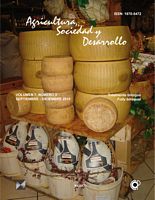Mules forgotten by colonial agricultural history: restitution
Abstract
Until the arrival of the Spaniards during the 16th Century,
mesoamerican agriculture did not use the force of domestic
animals to carry out agricultural practices or to transport loads
and people. It was the colonizers who, motivated by the need
to produce food and merchandise characteristic of the Old
World culture, and for transportation in the new conquered
lands, introduced animals, harnesses and their utilization
technology. We know that the Spanish tradition prefers bovines
as draft animals for instruments and vehicles, while horses
are appreciated as mount animals and mules are useful for
load transport. However, in the document entitled Haciendas
y Ranchos de Tlaxcala en 1712, the result of a census in
Spanish farms commissioned by the King, there is information
about mules present in estates at the time, which were used
fundamentally as draft animals for plowing, contradicting the
idea that this species was preferred as a pack animal.
Downloads
Published
How to Cite
Issue
Section
License
Authors who publish in this journal accept the following conditions:
- The authors retain the copyright and transfer to the magazine the right of the first publication, with the work registered with the Creative Commons attribution license, which allows third parties to use what is published as long as they mention the authorship of the work and the first publication in this magazine.
- Authors may make other independent and additional contractual arrangements for non-exclusive distribution of the version of the article published in this journal (e.g., including it in an institutional repository or publishing it in a book) as long as they clearly indicate that the work It was first published in this magazine.
- Authors are permitted and encouraged to publish their work on the Internet (for example on institutional or personal pages) before and during the review and publication process, as it can lead to productive exchanges and greater and faster dissemination of the work. published (see The Effect of Open Access).













